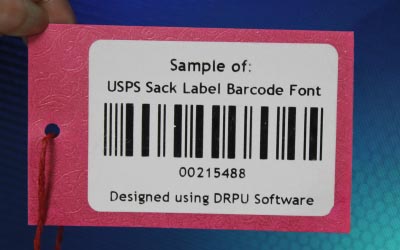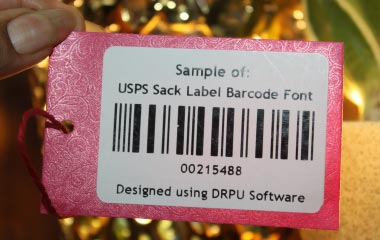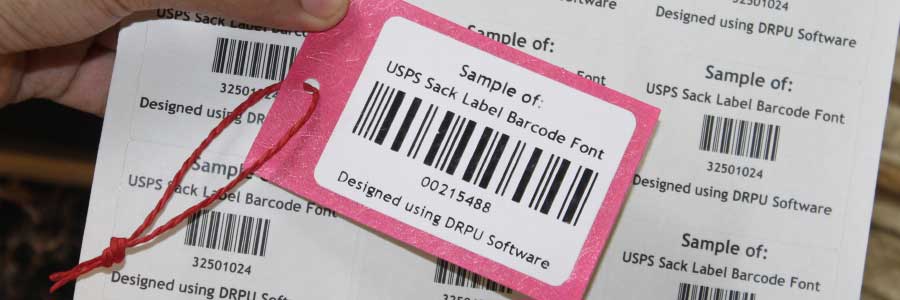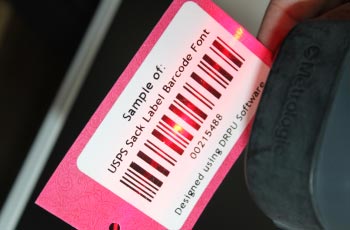Structure Of USPS Sack Label Barcode
The structure of a USPS sack label barcode is defined by the United States Postal Service (USPS) in their Publication 199: Intelligent Mail Package Barcode (IMpb) Implementation Guide. The barcode is a 4-state barcode that is printed on a label affixed to the outside of a mail sack, and it encodes a unique identifier for the sack to allow it to be tracked and sorted automatically by postal processing equipment.These elements are arranged in a specific pattern to encode the information needed to track and process the mail sack.
The USPS sack label barcode is made up of four different types of bars and spaces, each with a different width and height:-

1 The first element of the barcode is the Start pattern, which consists of two bars of equal width followed by a space. This signals the beginning of the barcode and indicates to the scanner that it is a USPS sack label barcode.
2 The second element of the barcode is the Mailer ID (MID), which is a 9-digit number assigned by the USPS to identify the mailer or shipping company that is sending the mail. The MID is encoded using a series of bars and spaces that correspond to the digits of the number. Each digit is encoded using two bars and two spaces, with the width and height of each element varying depending on its position in the sequence.
3 The third element of the barcode is the Serial Number, which is a 9-digit number assigned by the mailer to uniquely identify the mail sack. The Serial Number is encoded using the same method as the MID, with each digit represented by two bars and two spaces of varying width and height.
4 The fourth and final element of the barcode is the Stop pattern, which consists of a single bar followed by two spaces and a final bar. This signals the end of the barcode and tells the scanner that it has reached the end of the encoded data.
5 The entire barcode is printed in a 7-bit binary format using four different types of bars and spaces, each with a different width and height. The bars and spaces are arranged in a specific pattern to encode the MID, Serial Number, and Stop pattern in a way that can be read by automated postal processing equipment.
Advantages Of Using USPS Sack Label Barcode
USPS sack label barcode has several advantages, which include the following:
-
Reduced Paperwork:
USPS barcode helps the employees by eliminating the need of manual paperwork associated with the mail sorting process. USPS employees to scan mailpieces and record tracking information, reducing for manual documentation.
-
Ease of Use:
The USPS sack label barcode is easy to use and can be printed directly onto the mailpiece. This barcode can be easily scanned by USPS employees and automated sorting equipment, which streamlines the sorting process.
-
Enhanced Tracking:
The USPS sack label barcode allows USPS to track mailpieces as they move through the postal system. This tracking information provides greater visibility and transparency to both USPS and customers. It enables customers to track their packages online and provides real-time updates on the status of their shipments.
-
Cost Savings:
The USPS sack label barcode helps to reduce costs associated with the manual handling of mail. Automated sorting reduces the need for human intervention in the sorting process, which can be expensive. This barcode also reduces errors and mis-sorting of mailpieces, which can save money in terms of rework and lost packages.
-
Greater Accuracy:
The USPS sack label barcode ensures that mailpieces are properly sorted and delivered to the correct destination. This barcode type helps to reduce errors associated with manual sorting, which can lead to misdeliveries, lost packages, and unhappy customers due to poor satisfaction.
-
Universal Acceptance:
The USPS sack label barcode is universally accepted by USPS, which means that all USPS facilities and employees can read and process the barcode. This barcode is also recognized by many other postal services around the world, which makes it an excellent choice for international shipping.
-
Improved Efficiency:
One of the significant advantages of using USPS sack label barcode is that it improves the efficiency of the mail sorting process. The barcode provides automated sorting of mailpieces, allowing USPS to handle larger volumes of mail more quickly and accurately.
📝Summary The USPS sack label barcode provides several benefits to both USPS and customers. It improves the efficiency of the mail sorting process, enhances tracking, reduces costs, increases accuracy, is easy to use, and has universal acceptance.
Minimum and Maximum Length Of USPS Sack Label Barcode
The United States Postal Service (USPS) sack label barcode is used to track and sort mail sacks as they move through the mail processing system. The barcode encodes a unique identifier that provides information about the origin, destination, and contents of the mail sack. In this answer, we will explore the minimum and maximum length of the USPS sack label barcode in greater detail.
Minimum Length:The minimum length of the USPS sack label barcode is 31 characters. This is because the barcode encodes a 31-digit alphanumeric code that includes information about the mail sack. The 31-digit code is composed of the following elements:

🟆 Origin ZIP Code - The 5-digit ZIP Code of the origin facility.
🟆 Destination ZIP Code - The 5-digit ZIP Code of the destination facility.
🟆 Mailer ID - A 6-digit code that identifies the mailer.
🟆 Service Type ID - A 3-digit code that identifies the type of service being used.
🟆 Mailer-Assigned Routing Code - A 9-digit code assigned by the mailer to identify the mail sack.
In addition to these five elements, the 31-digit code may also include check digits and other characters used for error detection and correction. The minimum length of the USPS sack label barcode ensures that all necessary information is encoded in the barcode to enable the USPS to track and sort mail sacks efficiently.
Maximum Length:The maximum length of the USPS sack label barcode is not specifically defined by the USPS. However, the maximum length is limited by the capacity of the barcode symbology used to encode the data. The USPS sack label barcode uses a modified version of Code 128 symbology, which can encode up to 128 ASCII characters.
USPS may require that additional information, such as the weight or volume of the mail sack, be encoded in the barcode to enable more efficient sorting and processing of the mail. In such cases, the length of the USPS sack label barcode may exceed the minimum length of 31 characters.
In practice, the maximum length of the USPS sack label barcode is determined by the amount of information that needs to be encoded in the barcode to identify and track the mail sack. The 31-digit alphanumeric code used in the barcode provides enough information to track and sort the mail sack, but additional information may be added to the barcode to provide more detailed tracking information or to comply with specific USPS requirements.
Download and Install Barcode Software
📝 Summary: minimum length of the USPS sack label barcode is 31 characters, which is sufficient to encode all necessary information about the mail sack. The maximum length of the barcode is not specifically defined, but is limited by the capacity of the barcode symbology used to encode the data, as well as the amount of information needed to identify and track the mail sack.
Print Of USPS Sack Label Barcode
Printing a USPS sack label barcode is a simple process that involves a few key steps. In this essay, we will explain the steps involved in printing a USPS sack label barcode, including the required equipment and software, and provide some tips for ensuring that the barcode is printed correctly.

Step 1: The first step in printing a USPS sack label barcode is to obtain the necessary equipment and software. To print a USPS sack label barcode, you will need a printer that can produce high-quality barcodes, such as a thermal transfer or direct thermal printer. You will also need to use USPS-approved labels that are specifically designed for sack labels. Additionally, you will need to use specialized software provided by USPS, such as the PostalOne! software, to generate and print the barcode.
Step 2: The next step is to create the USPS sack label barcode. To do this, you will need to enter the required information into the PostalOne! software. This information includes the origin and destination of the mail, the type of mail, and the weight of the mail sack. The software will then generate a unique barcode for the mail sack based on this information. You will need to ensure that the information you enter is accurate, as any errors could cause delays in the delivery of your mail.
Step 3: Once you have generated the USPS sack label barcode, the next step is to print it. To print the barcode, you will need to use the specialized software provided by USPS, which will allow you to select the appropriate label size and format. You will then need to select the printer you wish to use and adjust the printer settings to ensure that the barcode is printed at a high resolution and with the correct orientation.
Step 4: When printing the barcode, it is essential to ensure that the label is correctly aligned and positioned on the label sheet. You will also need to ensure that the printer is calibrated to print at the correct size and with the correct spacing. It is also important to ensure that the printer is set to print in black ink on a white background, as this will provide the highest contrast and legibility.
Step 5: Once the barcode has been printed, you will need to affix the label to the mail sack. The USPS specifies the correct location for the label, which is on the top of the sack, centered on the seam, and aligned with the bottom of the sack. The label should be securely affixed to the sack to prevent it from coming off during transport.
📝 Conclusion: In conclusion, printing a USPS sack label barcode is a relatively simple process that requires the use of specialized software and equipment. The key steps involved in printing a USPS sack label barcode include generating the barcode using the PostalOne! software, selecting the appropriate label size and format, adjusting the printer settings to ensure a high-quality print, affixing the label to the mail sack in the correct location, and ensuring that the label is securely attached to the sack. By following these steps and ensuring that the barcode is printed correctly, you can ensure the efficient and accurate tracking and delivery of your mail.
Scan a USPS Sack Label Barcode

➦Scanning a USPS sack label barcode is an important step in the process of tracking and delivering mail. It enables postal workers to quickly and accurately identify the origin and destination of a mail sack, as well as its contents and any special handling requirements. In this essay, we will explain the steps involved in scanning a USPS sack label barcode, including the necessary equipment and software, and provide some tips for ensuring that the barcode is scanned correctly.
➦ Scanning a USPS sack label barcode is a relatively simple process that requires the use of specialized equipment and software. The key steps involved in scanning a USPS sack label barcode include positioning the mail sack in front of the scanner, ensuring that the scanner is properly calibrated and configured, scanning the barcode using the trigger button on the scanner, and ensuring that the barcode is scanned correctly and completely. By following these steps and ensuring that the barcode is scanned correctly, you can ensure the efficient and accurate tracking and delivery of your mail.
Download and Install Barcode Software
📝 Summary Structure of a USPS sack label barcode consists of a Start pattern, Mailer ID (MID), Serial Number, and Stop pattern. The barcode is printed in a 7-bit binary format using four different types of bars and spaces, each with a different width and height, and is arranged in a specific pattern to encode the necessary information for tracking and processing the mail sack. The barcode is typically printed on a label that is affixed to the outside of the mail sack and is read by automated postal processing equipment to track the location and status of the mail sack.
International Usage of USPS Sack Label Barcode
The USPS sack label barcode is a unique barcode that is used by the United States Postal Service (USPS) to identify and track mail sacks as they move through the mail processing system. While this barcode is specifically designed for use within the USPS system, it may also be used for international mail in certain situations. In this essay, we will explore the use of USPS sack label barcodes in international mail and discuss their limitations and advantages.
International Mail Processing: International mail processing can be a complex and time-consuming process, as packages and parcels must be sorted and processed by multiple postal services in different countries. To facilitate this process, many postal services around the world use a standardized system of barcodes and tracking codes that allow them to track and monitor the progress of a shipment as it moves through the system. The Universal Postal Union (UPU) has established standards for these codes and requires that all member countries adhere to them when processing international mail.
USPS Sack Label Barcodes and International Mail: While the USPS sack label barcode is designed for use within the USPS system, it may also be used for international mail in certain situations. For example, if a mail sack is being transported from the United States to another country, the USPS may attach a sack label barcode to the sack to help track its progress through the international mail system. However, it is important to note that not all countries and postal services are able to read USPS sack label barcodes, as they may not have the necessary scanning equipment or software.
In addition to the limitations of the international mail system, there are also limitations to the use of USPS sack label barcodes in international mail. One limitation is that the barcode may not be recognized by the receiving postal service, which could result in delays or errors in the processing of the shipment. Another limitation is that the barcode may not be compatible with the tracking systems used by the receiving postal service, which could make it difficult to track the progress of the shipment as it moves through the system.
Advantages of Using USPS Sack Label Barcodes in International Mail:
1 Despite these limitations, there are also advantages to using USPS sack label barcodes in international mail. One advantage is that they provide a standardized method of tracking and monitoring the progress of a shipment, which can help to ensure that the shipment arrives at its destination on time and in good condition. They also provide a record of the shipment's journey through the postal system, which can be useful in the event of a dispute or lost shipment.
2 Another advantage of using USPS sack label barcodes in international mail is that they are compatible with the tracking systems used by many postal services around the world. This means that the shipment can be tracked and monitored by the sender and receiver, as well as by the postal services handling the shipment, which can help to ensure that it arrives at its destination on time and in good condition.
📝Conclusion In conclusion, while the USPS sack label barcode is primarily designed for use within the USPS system, it may also be used for international mail in certain situations. However, there are limitations to its use in the international mail system, including the compatibility of the barcode with the tracking systems used by receiving postal services. Despite these limitations, there are also advantages to using USPS sack label barcodes in international mail, including the standardized method of tracking and monitoring shipments and the compatibility of the barcode with tracking systems used by many postal services around the world.